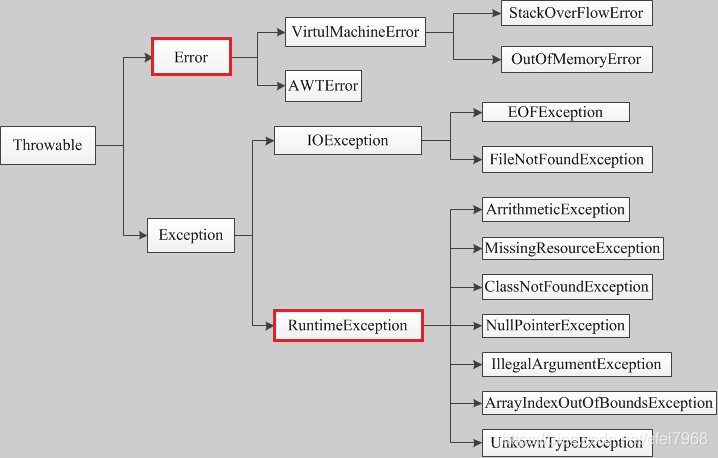Java异常
异常

error
Error描述了Java运行时系统的内部错误和资源耗尽错误,如堆溢出和栈溢出
堆溢出:OutOfMemoryError
- 如果虚拟机在扩展栈时无法申请到足够的空间,则抛出此异常
栈溢出:StackOverFlowError
- 如果线程请求的栈深度大于虚拟机所允许的深度,就会抛出此异常
excption
Exception分为运行时(RunTimeException)和其他异常(IOException/SqlException)
RunTimeException:NullPointerException,ArithmeticException,IndexOutOfBoundsException
受检异常和非受检异常
非受检异常:指编译期免检异常,包括派生于Error或RunTimeException类的所有异常。
受检异常:指编译时强制检查的异常,包括非受检异常的所有的其他异常。
异常处理
异常处理的本质是抛出异常和捕获异常
Java的异常处理是通过5个关键词来实现的:try、catch、throw、throws和finally。
- try用来指定一块预防所有异常的程序。
- catch子句紧跟在try块后面,用来指定你想要捕获的异常的类型;
- throw语句用来明确地抛出一个异常;
- throws用来声明一个方法可能抛出的各种异常;
- finally为确保一段代码不管发生什么异常状况都要被执行,在 finally 代码块中,可以运行清理类型等收尾善后性质的语句。
1 | if (name == null) { |
其中finally一定是会执行的
如果try中没有异常,就按照try-finally执行
如果try中有异常,就执行到try中有异常的位置,然后执行catch,最后执行finally
try-catch-finally中有return
try中有return
1 | public class trycatch { |
输出:
try2
finally3
return2
catch中有return
1 | public class trycatch { |
输出:
try2
catch3
finally4
return3
finally中有return
1 | public class trycatch { |
输出:
try2
catch3
finally4
return4
执行顺序:先执行try和catch中return之前的语句,然后暂时保存return的值,等执行完finally之后,再返回之前保存的return的值。
如果finally中包含return语句,则前面try和catch中的return失效,但是不推荐这样写。
- 本文标题:Java异常
- 本文作者:Kang
- 创建时间:2021-04-10 14:50:10
- 本文链接:ykhou.github.io2021/04/10/Java异常/
- 版权声明:本博客所有文章除特别声明外,均采用 BY-NC-SA 许可协议。转载请注明出处!